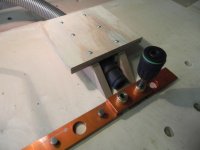You are using an out of date browser. It may not display this or other websites correctly.
You should upgrade or use an alternative browser.
You should upgrade or use an alternative browser.
UJK Parf Guide System - Videos
- Thread starter Stone Message
- Start date
Steve Rowe said:Thanks for the status Shane.
Hi Steve
I have nothing to do with Axminster's business arrangements and I am sorry that the PGS is not available directly in North America. However, Axminster have established a very efficient delivery system to NA (and ROW) with reports of 3-6 days from ordering to delivery. You can shop in US $ on the Axminster web site and you do not have to pay the European sales tax which gives a 20% saving up front.
Peter
stvrowe
Member
- Joined
- Jan 27, 2007
- Messages
- 834
Peter Parfitt said:Steve Rowe said:Thanks for the status Shane.
Hi Steve
I have nothing to do with Axminster's business arrangements and I am sorry that the PGS is not available directly in North America. However, Axminster have established a very efficient delivery system to NA (and ROW) with reports of 3-6 days from ordering to delivery. You can shop in US $ on the Axminster web site and you do not have to pay the European sales tax which gives a 20% saving up front.
Peter
Thanks Peter, I will check it out.
Steve
squarecut
Member
- Joined
- Dec 2, 2013
- Messages
- 187
Finally found time to make Peter Parfitt's UJK Parf Guide System storage box. I wanted to protect the Parf sticks and Peter's box intrigued me. I basically followed Peter's plans, however I modified the box slightly to my own liking. It is a bit longer & wider, finishing out at 1074mm long x 77mm wide. I used 9.5 mm magnets (3/8") so I increased the quantity, using 3 at the Parf sticks end cap & 1 additional at the rear of the drawer just to be assured that there was enough magnetic attraction. Fabricated out of scrap red oak left from a project. I also made a cradle for the long parf dogs. All in all it worked out great.
Thanks Peter for a unique storage idea for an equally unique shop tool.
Thanks Peter for a unique storage idea for an equally unique shop tool.
Attachments
-
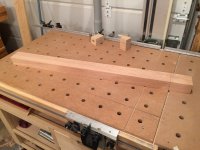 PFGB 05.JPG1.5 MB · Views: 982
PFGB 05.JPG1.5 MB · Views: 982 -
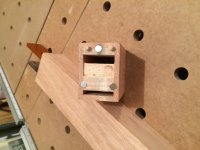 PFGB 14.JPG1.5 MB · Views: 793
PFGB 14.JPG1.5 MB · Views: 793 -
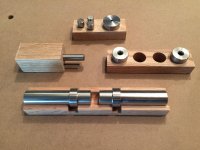 PFGB 13.JPG806.5 KB · Views: 830
PFGB 13.JPG806.5 KB · Views: 830 -
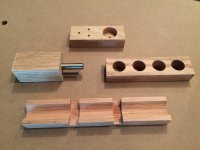 PFGB 12.JPG1.5 MB · Views: 792
PFGB 12.JPG1.5 MB · Views: 792 -
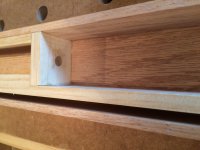 PFGB 11.JPG1.7 MB · Views: 738
PFGB 11.JPG1.7 MB · Views: 738 -
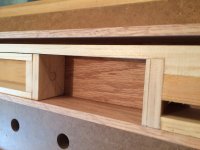 PFGB 10.JPG1.3 MB · Views: 729
PFGB 10.JPG1.3 MB · Views: 729 -
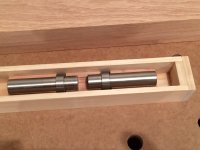 PFGB 09.JPG499 KB · Views: 778
PFGB 09.JPG499 KB · Views: 778 -
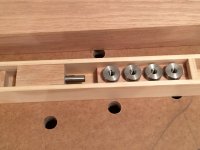 PFGB 08.JPG1.2 MB · Views: 815
PFGB 08.JPG1.2 MB · Views: 815 -
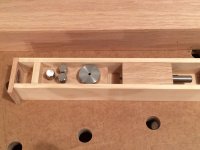 PFGB 07.JPG1.2 MB · Views: 845
PFGB 07.JPG1.2 MB · Views: 845 -
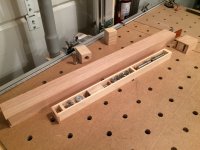 PFGB 06.JPG1.6 MB · Views: 985
PFGB 06.JPG1.6 MB · Views: 985
[member=26002]squarecut[/member] that is far superior to my meagre efforts - well done.
I really like the various inserts for the long drawer, particularly the one for the pair of Parf Dogs.
Brilliant.
Peter
I really like the various inserts for the long drawer, particularly the one for the pair of Parf Dogs.
Brilliant.
Peter
clark_fork
Member
- Joined
- Apr 7, 2015
- Messages
- 306
I found drilling went smoother when I adopted Peter's method of using the vac hose against the guide. However, it calls for holding it in place during the drilling. That was awkward. In minutes, I created a shoe to align the hose and now I have a PGS dust extractor feature.
[attachimg=1]
[attachimg=1]
Attachments
Xoncention
Member
- Joined
- Aug 17, 2015
- Messages
- 111
Forstner bits require clearance above them to expel the shavings, otherwise these build up around the cutting edges and this causes heat to be generated and this will cause the bit to expand and the clearances reduced further with more friction between surfaces. Your idea looks like an efficient and less cumbersome solution and you have all your attention in the area required. Nice solution. 8)clark_fork said:I found drilling went smoother when I adopted Peter's method of using the vac hose against the guide. However, it calls for holding it in place during the drilling. That was awkward. In minutes, I created a shoe to align the hose and now I have a PGS dust extractor feature.
clark_fork said:I found drilling went smoother when I adopted Peter's method of using the vac hose against the guide. However, it calls for holding it in place during the drilling. That was awkward. In minutes, I created a shoe to align the hose and now I have a PGS dust extractor feature.
Excellent idea.
Peter
All:
I think I managed to get the 20mm bit stuck in the main bushing. Kind of surprising as I had sprayed a generous amount of WD-40 before and during drilling and I had only drilled about 9 holes before this happened. I'm guessing I was somehow still generating too much heat (I was continually removing the shavings using a vacuum as well).
Am I out of luck or is there some way I can salvage this? I'm hoping that I don't have to purchase a new set to complete this. I had finished all my 3mm holes and was in the process of drilling my 20mm holes when this happened. I still have something like 200 more holes to go :-(
Any suggestions are most welcome.
Anil
I think I managed to get the 20mm bit stuck in the main bushing. Kind of surprising as I had sprayed a generous amount of WD-40 before and during drilling and I had only drilled about 9 holes before this happened. I'm guessing I was somehow still generating too much heat (I was continually removing the shavings using a vacuum as well).
Am I out of luck or is there some way I can salvage this? I'm hoping that I don't have to purchase a new set to complete this. I had finished all my 3mm holes and was in the process of drilling my 20mm holes when this happened. I still have something like 200 more holes to go :-(
Any suggestions are most welcome.
Anil
clark_fork
Member
- Joined
- Apr 7, 2015
- Messages
- 306
You likely have a burr on the shaft from the Jacobs chuck. Feel for the burr and hit it with a file. The bit will then slide out of the guide.
The Jacobs chuck does not need much muscle to seat the bit into the chuck. Go a little bit more softly next time. WD-40 is good but old fashion 3/1 has better staying power as a lubricant. I don't know if they sell it anymore.
The Jacobs chuck does not need much muscle to seat the bit into the chuck. Go a little bit more softly next time. WD-40 is good but old fashion 3/1 has better staying power as a lubricant. I don't know if they sell it anymore.
clark_fork said:You likely have a burr on the shaft from the Jacobs chuck. Feel for the burr and hit it with a file. The bit will then slide out of the guide.
The Jacobs chuck does not need much muscle to seat the bit into the chuck. Go a little bit more softly next time. WD-40 is good but old fashion 3/1 has better staying power as a lubricant. I don't know if they sell it anymore.
Thanks Clark. I ended up (very gently) hammering the bit out of the bushing and cleaning it. When I try to put it back in the bushing, after a little bit of initial friction it seems to be able to go back in and slide okay. This time, I've put a generous coating of grease and will see how it goes. At the very least I know that I can get a new bit and use the other bushing that I have not managed to mess up
Anil
Hi [member=537]anilveena[/member]
I am sorry that you have had this problem. It can occur if the upper shaft of the 20 mm bit has been damaged in the chuck. There have been a couple of other cases and none of them had any reported damage to the bushing and were solved in much the same way that [member=49013]clark_fork[/member] described.
I will investigate ways to minimise the likelihood of this happening and will report back soon. In the meantime I suggest that people tighten their chucks so that there is less chance of slippage.
Peter
I am sorry that you have had this problem. It can occur if the upper shaft of the 20 mm bit has been damaged in the chuck. There have been a couple of other cases and none of them had any reported damage to the bushing and were solved in much the same way that [member=49013]clark_fork[/member] described.
I will investigate ways to minimise the likelihood of this happening and will report back soon. In the meantime I suggest that people tighten their chucks so that there is less chance of slippage.
Peter
Thanks Peter, I will be a little more careful going forward. I drilled a few more holes after my mishap and they seem to be coming out okay (I'm checking by inserting the Veritas mini-dogs and checking if there's any play).
Thanks again for the ingenious jig and the super helpful videos!
Anil
Thanks again for the ingenious jig and the super helpful videos!
Anil
Peter Parfitt said:Hi [member=537]anilveena[/member]
I am sorry that you have had this problem. It can occur if the upper shaft of the 20 mm bit has been damaged in the chuck. There have been a couple of other cases and none of them had any reported damage to the bushing and were solved in much the same way that [member=49013]clark_fork[/member] described.
I will investigate ways to minimise the likelihood of this happening and will report back soon. In the meantime I suggest that people tighten their chucks so that there is less chance of slippage.
Peter
Michael Kellough
Member
Peter Parfitt said:Hi [member=537]anilveena[/member]
I am sorry that you have had this problem. It can occur if the upper shaft of the 20 mm bit has been damaged in the chuck. There have been a couple of other cases and none of them had any reported damage to the bushing and were solved in much the same way that [member=49013]clark_fork[/member] described.
I will investigate ways to minimise the likelihood of this happening and will report back soon. In the meantime I suggest that people tighten their chucks so that there is less chance of slippage.
Peter
Murphy's law.
Room for improvement.
The chuck end of the 20mm bit should be reduced diameter.
Michael Kellough said:Murphy's law.
Room for improvement.
The chuck end of the 20mm bit should be reduced diameter.
That is an excellent suggestion but something a little better may be possible.
Many thanks.
Peter
Michael Kellough
Member
What do you have in mind?
clark_fork
Member
- Joined
- Apr 7, 2015
- Messages
- 306
Michael Kellough said:What do you have in mind?
Zobo? Tougher metal for bit? Just a non-Forstner brad-point bit? A new router-based model PGS eliminating drilling altogether? ( I know... it already exists..(LR32) but a PGS router platform using the 3mm pin system ensures easy layout and presumably more accurate placement.
I got terrible tear out on a Baltic-ply top. Next time, I will try a clamped on backer board. If that does not solve it, I would allocate some time and just flip and do starter holes, then flip again and finish off. The 3mm holes do go through the stock so coming up from the bottom should work.
Another tip: For repetitive work, I found frequent swapping to fresh batteries seemed to work after I got started. Again, I have to say using the vac turned out to be very essential to smooth cutting. Also, the removable Festool Jacobs chuck is one of the best reasons to own a Festool drill.
Hi Clark
It took 3 years to develop the PGS and any changes will receive the same amount of development and testing. There is nothing new for the immediate future although new ideas crop up all the time.
As far as breakout goes... a backing board is a good idea with difficult material but the design of the 20 mm cutter is such that it ought not to happen unless the user pushes too hard whilst cutting. I know that with loads of holes to drill one wants to crack on at a pace but the last 2 mm of each cut need to be done with care.
It is also a good idea to avoid overheating the cutter. I can't remember the figure but I mention it in one of the videos - I think I drill about 4 of the 20 mm holes per minute.
I promise to keep everyone up to speed if there is anything new around the corner.
Peter
It took 3 years to develop the PGS and any changes will receive the same amount of development and testing. There is nothing new for the immediate future although new ideas crop up all the time.
As far as breakout goes... a backing board is a good idea with difficult material but the design of the 20 mm cutter is such that it ought not to happen unless the user pushes too hard whilst cutting. I know that with loads of holes to drill one wants to crack on at a pace but the last 2 mm of each cut need to be done with care.
It is also a good idea to avoid overheating the cutter. I can't remember the figure but I mention it in one of the videos - I think I drill about 4 of the 20 mm holes per minute.
I promise to keep everyone up to speed if there is anything new around the corner.
Peter
gunnyr
Member
Peter Parfitt said:Hi [member=537]anilveena[/member]
I am sorry that you have had this problem. It can occur if the upper shaft of the 20 mm bit has been damaged in the chuck. There have been a couple of other cases and none of them had any reported damage to the bushing and were solved in much the same way that [member=49013]clark_fork[/member] described.
I will investigate ways to minimise the likelihood of this happening and will report back soon. In the meantime I suggest that people tighten their chucks so that there is less chance of slippage.
Peter
I bought the UJK Parf Guide to make the [member=6227]crpaulk[/member] 3x6 workbench. After boring and checking the 162 holes yesterday I can tell you that I am most impressed!
I used my CXS to drill the holes and found that I needed to change the batteries after 30 or so holes. The removeable chuck was a great help! I had the same issue with the stuck bit just yesterday and solved it just as [member=49013]clark_fork[/member] did!
I am making the top out of cabinet grade birch and finding that the tearout can be reduced with a backer board. I did not clamp the backer but rather just placed it between the top and my sawhorse as I bored each row.
gunnyr said:Peter Parfitt said:Hi [member=537]anilveena[/member]
I am sorry that you have had this problem. It can occur if the upper shaft of the 20 mm bit has been damaged in the chuck. There have been a couple of other cases and none of them had any reported damage to the bushing and were solved in much the same way that [member=49013]clark_fork[/member] described.
I will investigate ways to minimise the likelihood of this happening and will report back soon. In the meantime I suggest that people tighten their chucks so that there is less chance of slippage.
Peter
I bought the UJK Parf Guide to make the [member=6227]crpaulk[/member] 3x6 workbench. After boring and checking the 162 holes yesterday I can tell you that I am most impressed!
I used my CXS to drill the holes and found that I needed to change the batteries after 30 or so holes. The removeable chuck was a great help! I had the same issue with the stuck bit just yesterday and solved it just as [member=49013]clark_fork[/member] did!
I am making the top out of cabinet grade birch and finding that the tearout can be reduced with a backer board. I did not clamp the backer but rather just placed it between the top and my sawhorse as I bored each row.
Many thanks.
Semper Fidelis my friend.
Peter
Similar threads
- Replies
- 2
- Views
- 820
- Replies
- 0
- Views
- 195

